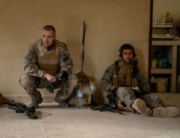

Flee depicts the life story of Amir Nawabi (a pseudonym) via vibrant 2D animation. Why this format for the biography of an Afghan refugee and now a 36-year-old Danish researcher at Princeton? According to director Jonas Poher Rasmussen, who has known Amir for 25 years, it was a way to re-create the history of Afghanistan in the 1980s and Moscow right after the collapse of the Soviet Union. (His choice of format sure beats cheesy reenactments.)
The animation gives his subject anonymity and provides a fluidity with lucid, smooth visual transitions from the present to the past and back. As a result, Rasmussen enhances Amir’s story, who otherwise would be a reticent narrator, as an empathetic and engaging storyteller. It also renders the perspective of a queer adolescent, who dreamily imagines a shirtless Jean-Claude Van Damme winking at him from the TV screen.
The director met Amir in his Danish small-town high school in the mid-1990s. Rumor had it that Amir had walked all the way from Afghanistan. That was not the case, but how he arrived alone to Europe is what distinguishes Flee from other works that use Afghanistan as a launching point. Magnusson focuses less on the ongoing wars in that country and more on the threats faced by Amir and his family in trying to get out of, first, Afghanistan and then Russia, where they were stuck in limbo.
The movie begins like a therapy session, with animated versions of the director (who has a background in radio documentaries) asking Amir, reclined on a couch, what “home” means to him. This may provide an answer to why he diffidently commits to living with his fiancé, Kasper. Anecdote by anecdote, the soft-spoken Amir unburdens himself before the filmmaker, revealing a long held, tightly kept secret about his past. He comes out, so to speak, twice during the course of the session.
Amir grew up in Kabul with a pilot father who disappeared when he was forced to fight the mujahideen in the 1980s. As a boy, Amir runs around a neighborhood street in one of his older sister’s dresses, dancing to A-ha’s “Take on Me” blaring on his Walkman. In his omnipresent voiceover, he admits he always knew he was different. The family, as portrayed here, is a prototypical secular household, part of the middle class that is often seen in archival footage in documentaries about life before the Soviet invasion.
Notably, the narrative’s only inference to religion is the threat of the Taliban, who rose to power in the 1990s after the Soviet Union collapsed and Russian forces departed the country. This causes Amir, one older brother, two sisters, and their mother to flee to Russia, the only country that would issue them tourist visas. There they spend their days in a threadbare Moscow high-rise apartment watching Mexican soap operas—and rarely going outside to avoid the police after their visas expire—while waiting for the eldest brother in Sweden to send money for traffickers to lead them westward.
The accounts of the clandestine crossings are expertly paced, making Flee perhaps the most suspenseful film of 2021. It’s also the best example since Waltzing with Bashir of nightmarish and surreal horror in animation. The colors of the hand-drawn graphics pop out from the screen while the more sinister episodes are reflected in charcoal flashbacks.
After the original Danish version’s premiere at Sundance, Neon acquired the documentary hybrid and will release it, along with Participant, in the United States in English, with Riz Ahmed (Sound of Metal) voicing Amir and Nikolaj Coster-Waldau (Game of Thrones) as Rasmussen—both are executive producers.
















Leave A Comment